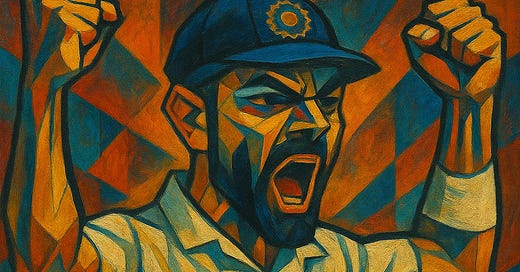Long live the King: An ode to the face of India’s modern Test renaissance
Perhaps the hardest part to accept is that the man who always believed, the one who made us believe against all odds, no longer believed he had more to give.
In 2001, I was a 10-year-old kid batting at No. 3 for my cricket academy, just as Rahul Dravid was entering the most prolific purple patch of his career. As Dravid perfected the art of defense and piled up runs in England to help India draw a series, loving him came easy. He embodied everything I was taught to aspire for: putting the team before self, working relentlessly, staying humble. His country-first mindset seemed like the only way to play the game. His struggles felt personal, so when India dropped him from ODIs in 2008, I staged my own childish revolt — refusing to watch the next series (yes, I get irony now).
When Dravid retired, I’d come to understand the quiet heartbreak of seeing your hero move on. In most ways, Virat Kohli was nothing like Dravid. He rightly reminded many of Ricky Ponting - Loud, collar up, unapologetically confident, not afraid to pick a fight. He already had a World Cup medal and yet, despite growing up in Delhi and seeing that kind of cockiness all around me, I couldn’t relate to Kohli at first.
By the time Kohli became the heartbeat of India’s Test team, I was a bit older, a bit wiser, perhaps a touch less emotional. None of that mattered though because if you watched Kohli long enough, you couldn’t help but be won over. Whether it was his unrelenting energy, his fierce competitiveness, or the sheer weight of runs scored, Kohli didn’t just play the game — he commanded it.
He didn’t just walk into the spotlight—he became it. With his intensity, charisma, and sheer presence, he drew every eye, every camera, every heartbeat in the stadium. And sometimes, in that glare, you found yourself wanting to look elsewhere—to the quiet contributors, the unsung heroes, the ones who weren’t always center stage. But even when you tried, your gaze would return to him. Because whether you loved the fire or questioned the flame, Kohli made it impossible to look away.
The defining image of Kohli for me comes from the Adelaide Test in 2014. After nearly dragging India to an improbable chase of 364, the new captain walked back to the pavilion with a brilliant 141 to his name. As Mohammed Shami, the next batter, passed him on his way out, Kohli urged him to “believe”. Whether or not those exact words were spoken, it was clear from his body language — and that, more than anything, captured the essence of India’s Test journey under him. The captaincy passed from MS Dhoni, the cool-headed pragmatist, to Virat Kohli, the relentless dreamer as India went from No. 7 in the rankings to No. 1.
I’ve had the privilege of watching Kohli live on a few occasions—each one a memory etched in a different shade of intensity. Perhaps the best knock I saw in person was that gritty 76 at Centurion in 2023, where he stood tall not just because of his technical compactness but also the fact that only 1 other Indian managed to reach double figures. But to truly understand the phenomenon that was peak Kohli, you have to go further back to when Test jerseys didn’t have names or numbers. Of course, you didn’t need those to know who he was, his presence told you everything.
In 2018, I watched Kohli return to England, confronting old scars and emerging comfortably on top. There, he wasn’t just facing bowlers — he was dismantling long-held narratives. I didn’t get to witness his finest knock of the tour, that masterful 149 at Edgbaston when no other Indian batter crossed 30, but I was there in Southampton when the series was on the line. Seated beside an English father and son, they turned to me and asked what I thought of India’s chances of chasing 244. The realist in me quietly doubted. Yet when Kohli walked in at 17/2 and calmly built a partnership with his vice-captain, I could see it — the father and son believed because if anyone could bend the will of destiny, it was Kohli. That version of Kohli was different gravy — his success didn’t just feel probable, it felt inevitable.
As Virat Kohli entered the twilight of his career, the whispers of retirement grew louder with each passing Test. The fire in his eyes, the inexhaustible energy, the iconic celebrations — they rarely dimmed, but as the runs began to dry up, even the most loyal fans couldn’t help but wonder how much longer the magic would hold. With his sudden retirement, the realization hit hard — the hope for a few more masterpieces, one more roar, one more overseas conquest would remain unfulfilled. Perhaps the hardest part to accept is that the man who always believed, the one who made us believe against all odds, no longer believed he had more to give. But even in this ending, his legacy stands unshaken, and our gratitude runs deep.








